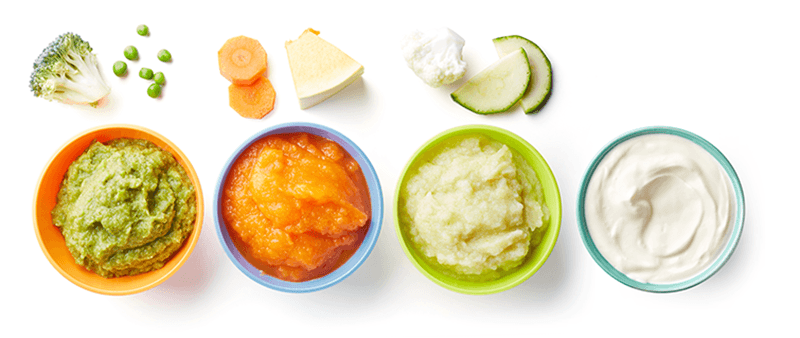
Homemade fermented milk products for children up to 2 years old
According to WHO (World Health Organization) recommendations, fermented milk products should be introduced into a child's diet from 8-10 months. From then on, nutrition with fermented milk products remains relevant for children of any age.

Complementary feeding with fermented milk products for babies
When to introduce the first complementary food
The first complementary food begins to be introduced between 4 and 7 months of age. This wide range is explained by the individuality of each baby and their mother: the child's growth rate, the volume and nutritional value of breast milk. Only the pediatrician who follows the baby can give recommendations here.

What foods to give the baby?
There are no clear recommendations on the order of introducing foods. Among the foods that should be introduced into the baby's diet in the first year of life are: vegetable and fruit purees, porridges and fermented milk products: yogurt, kefir and cottage cheese.
When teeth come in, you can gradually replace purees with chopped vegetables and fruits. Fermented milk products remain relevant for children of any age.
No matter which food you start with, fermented milk products should be introduced into the child's diet in the first year of life.

What should the products be like?
The baby's digestive system is very sensitive, so the quality of food for complementary feeding must meet strict requirements:
- it must be easily digested;
- it must contain sufficient nutrients and vitamins in the correct proportions;
- it must not contain any harmful substances;
- it must not cause digestive disorders;
- it must not cause allergic reactions.
In addition, for children under 1 year old, there are additional requirements:
- the product must be homogeneous, without unnecessary lumps;
- the product must be approximately at body temperature (+33..+37 ˚C).

Rules for introducing complementary feeding
- Readiness. The baby must be ready for the introduction of complementary foods. They should be able to sit up on their own without support.
- Health. You should not introduce new complementary foods during any illness or during injections.
- Steps. New foods should be introduced one at a time. Firstly, this will avoid overloading the digestive system. Secondly, if an allergic reaction occurs, it will be easy to identify which food caused it.
- Gradual increase in dose. New foods should be given for the first time in a very small amount - no more than ½ teaspoon, 1-2 times a day. Gradually increase (doubling the amount), until you reach the recommended dose for the child's age. The first doses of the new food should be given at the end of the usual meal.
- If something goes wrong. Sometimes a new food causes certain disturbances: a rash or digestive disorders. In this case, do not immediately give up the new product. Take a break for a few days (or try to introduce another food) and try to introduce the food again, starting with a half-teaspoon portion.

Why fermented milk products are better
Every child knows milk from the first years of life. And the baby's digestive system is designed to absorb dairy products as efficiently as possible. Fermented milk products, as a rule, are well tolerated by babies and do not cause allergic reactions or disorders. Since the amount of lactose decreases significantly during fermentation, fermented milk products are well tolerated even by children who have a reaction to normal milk.

It is not surprising that the most balanced product for children is milk. The baby grew up on milk (or a similar mixture) from birth, receiving all the nutrients from this unique product. Fermented milk products are the same milk, but in an even more universal form.
It contains:
- Protein, partially broken down into amino acids - a building block for muscles and organs.
- Fatty acids - necessary for the normal functioning of every cell in the body.
- Carbohydrates - the main source of energy. In addition, unlike whole milk, fermented milk products have much less lactose, which ensures excellent tolerance.
- Minerals - calcium, potassium, phosphorus, magnesium. For the development of the skeleton and the normal functioning of the body at the cellular level.
- Vitamin C, B vitamins, folic acid - essential for a growing organism.
Fermented milk products are not just food. The live bacteria in this product benefit the child's health:
![]()
protect the intestine from pathogenic and putrid microbes
![]()
strengthen the immune system
![]()
participate in digestion and vitamin formation.
Yogurt for children – natural and without unnecessary additives
The absence of harmful additives and excess sugar is especially important when it comes to children's nutrition. Some additives can also cause allergic reactions and digestive disorders. Finding a product without additives in the store is often not easy.
Great news – real yogurt, kefir, and cottage cheese can be prepared at home.
- 100% natural and definitely fresh;
- Does not contain harmful additives: preservatives, flavorings, dyes;
- Does not contain sugar;
- A truly living product - bacteria turn milk into yogurt right before your eyes;
Homemade yogurts contain more beneficial bacteria than supermarket yogurts. But it's not just the quantity that matters.
If you use a special probiotic starter culture – the yogurt will also be special. Probiotic bacteria not only turn milk into yogurt - they benefit the body.
Special beneficial bacteria in the starter culture provide the following beneficial properties:
- Intestinal microflora balance. Fermented milk products are a natural and effective way to restore the balance of intestinal microflora.
- Optimal digestion without failures. Special probiotic bacteria normalize digestive processes, preventing intestinal disorders.
- Strong immunity. Some starter cultures contain a special complex of bacteria, the regular use of which reduces the risk of colds in children by almost 2 times*
- Heat milk to a temperature of +37..+40 °C. Add the starter culture, mix.
- Wrap the pot in a large towel so the mixture doesn't cool down. Let it ferment for 6-8 hours.
- After thickening, cool the product. Before serving, you can add fruits, nuts, or honey.

VIVO starter cultures guarantee that you will have a great yogurt. Otherwise, you will receive compensation of 2 times the value of the milk and starter culture.
Find the right VIVO product for you
- Healthy food for children aged 2 and above.
- Restores microflora balance.
- Normalizes digestion.
- Strengthens the immune system
- Decreases risks of catching a cold
- Has an excellent taste and thick texture




